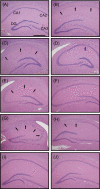The F gene of the Osaka-2 strain of measles virus derived from a case of subacute sclerosing panencephalitis is a major determinant of neurovirulence
- PMID: 20719945
- PMCID: PMC2953189
- DOI: 10.1128/JVI.01075-10
The F gene of the Osaka-2 strain of measles virus derived from a case of subacute sclerosing panencephalitis is a major determinant of neurovirulence
Abstract
Measles virus (MV) is the causative agent for acute measles and subacute sclerosing panencephalitis (SSPE). Although numerous mutations have been found in the MV genome of SSPE strains, the mutations responsible for the neurovirulence have not been determined. We previously reported that the SSPE Osaka-2 strain but not the wild-type strains of MV induced acute encephalopathy when they were inoculated intracerebrally into 3-week-old hamsters. The recombinant MV system was adapted for the current study to identify the gene(s) responsible for neurovirulence in our hamster model. Recombinant viruses that contained envelope-associated genes from the Osaka-2 strain were generated on the IC323 wild-type MV background. The recombinant virus containing the M gene alone did not induce neurological disease, whereas the H gene partially contributed to neurovirulence. In sharp contrast, the recombinant virus containing the F gene alone induced lethal encephalopathy. This phenotype was related to the ability of the F protein to induce syncytium formation in Vero cells. Further study indicated that a single T461I substitution in the F protein was sufficient to transform the nonneuropathogenic wild-type MV into a lethal virus for hamsters.
Figures






Similar articles
-
Amino acid substitutions in the heptad repeat A and C regions of the F protein responsible for neurovirulence of measles virus Osaka-1 strain from a patient with subacute sclerosing panencephalitis.Virology. 2016 Jan;487:141-9. doi: 10.1016/j.virol.2015.10.004. Epub 2015 Nov 2. Virology. 2016. PMID: 26524513
-
Cell-to-Cell Measles Virus Spread between Human Neurons Is Dependent on Hemagglutinin and Hyperfusogenic Fusion Protein.J Virol. 2018 Feb 26;92(6):e02166-17. doi: 10.1128/JVI.02166-17. Print 2018 Mar 15. J Virol. 2018. PMID: 29298883 Free PMC article.
-
Effect of the alterations in the fusion protein of measles virus isolated from brains of patients with subacute sclerosing panencephalitis on syncytium formation.Virus Res. 2007 Dec;130(1-2):260-8. doi: 10.1016/j.virusres.2007.07.017. Epub 2007 Sep 7. Virus Res. 2007. PMID: 17825451
-
Generation and properties of measles virus mutations typically associated with subacute sclerosing panencephalitis.Ann N Y Acad Sci. 1994 Jun 6;724:367-77. doi: 10.1111/j.1749-6632.1994.tb38934.x. Ann N Y Acad Sci. 1994. PMID: 8030963 Review.
-
[Subacute sclerosing panencephalitis (SSPE): viral mutation and neuropathogenicity].Uirusu. 2003 Jun;53(1):15-23. doi: 10.2222/jsv.53.15. Uirusu. 2003. PMID: 14556498 Review. Japanese. No abstract available.
Cited by
-
Mutated Measles Virus Matrix and Fusion Protein Influence Viral Titer In Vitro and Neuro-Invasion in Lewis Rat Brain Slice Cultures.Viruses. 2021 Apr 1;13(4):605. doi: 10.3390/v13040605. Viruses. 2021. PMID: 33916225 Free PMC article.
-
Mutant fusion proteins with enhanced fusion activity promote measles virus spread in human neuronal cells and brains of suckling hamsters.J Virol. 2013 Mar;87(5):2648-59. doi: 10.1128/JVI.02632-12. Epub 2012 Dec 19. J Virol. 2013. PMID: 23255801 Free PMC article.
-
Human parainfluenza virus evolution during lung infection of immunocompromised individuals promotes viral persistence.J Clin Invest. 2021 Dec 1;131(23):e150506. doi: 10.1172/JCI150506. J Clin Invest. 2021. PMID: 34609969 Free PMC article.
-
Construction and Preclinical Evaluation of a Recombinant Attenuated Measles Vaccine Candidate of the H1a Genotype.Vaccines (Basel). 2025 May 27;13(6):571. doi: 10.3390/vaccines13060571. Vaccines (Basel). 2025. PMID: 40573902 Free PMC article.
-
Structures of the prefusion form of measles virus fusion protein in complex with inhibitors.Proc Natl Acad Sci U S A. 2018 Mar 6;115(10):2496-2501. doi: 10.1073/pnas.1718957115. Epub 2018 Feb 20. Proc Natl Acad Sci U S A. 2018. PMID: 29463726 Free PMC article.
References
-
- Albrecht, P., and H. P. Schumacher. 1971. Neurotropic properties of measles virus in hamsters and mice. J. Infect. Dis. 124:86-93. - PubMed
-
- Albrecht, P., T. Burnstein, M. J. Klutch, H. T. Hicks, and F. A. Ennis. 1977. Subacute sclerosing panencephalitis: experimental infection in primates. Science 195:64-66. - PubMed
-
- Ayata, M., K. Hayashi, T. Seto, R. Murata, and H. Ogura. 1998. The matrix gene expression of subacute sclerosing panencephalitis (SSPE) virus (Osaka-1 strain): a comparison of two sibling viruses isolated from different lobes of an SSPE brain. Microbiol. Immunol. 42:773-780. - PubMed
Publication types
MeSH terms
Substances
LinkOut - more resources
Full Text Sources

